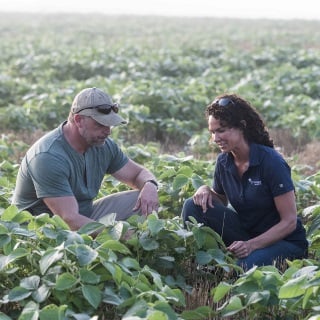With a successful harvest completed, it’s time to start thinking about next season’s crop insurance plan.
Some farmers resist making changes to their risk management plans and prefer to let their crop insurance policy renew as is. But this approach could be leaving money on the table or exposing them to unnecessary risk. Every season brings new challenges and opportunities, which means every aspect of your operation should be reviewed and updated to maximize your profit potential.
As we’ve discussed in the past, it’s important to partner with a team of experts to make sure you’re well informed during this process. We suggest enlisting a diverse group that includes a loan officer, a crop insurance specialist, and outside experts such as a grain marketer and insurance provider. The added visibility from such a team is crucial in attaining operational profitability. Follow these five steps in partnership with your team to help you secure the right amount of coverage to position your business for success, no matter what the next year brings.
1. Report your production numbers.
An updated and accurate balance sheet is critical to your operation’s success, especially when it comes to crop insurance planning. The sooner you provide this year's production numbers to your crop insurance specialist and loan officer, the sooner you can have an accurate picture of your coverage options.
Production numbers are added to your farm’s 10-year production history to calculate accurate crop insurance quotes. They also help your loan officer understand your lending needs and renew your operating line, if necessary. Other information to report at this stage includes:
Grain being carried over from this year’s harvest. An adjuster will measure your bins to provide an accurate number of bushels, which your loan officer can reflect in your balance sheet. Crop insurance claims from the past growing season as a result of low yield. This provides greater clarity to your lender about where you stand.
2. Estimate next year's crop input costs.
From seed and chemicals to fertilizer and fuel, every farmer should know expected input costs in detail. This is perhaps the single most important part of crop insurance planning, yet many farmers are satisfied with the general lump sum they keep in their heads. Incorrect or insufficient record keeping is the most common mistake we see. It may seem like a chore, but being off by a few thousand dollars here and there can quickly add up.
An accurate understanding of your expected cost of production gives you two pieces of critical information: how much money is required to grow your crops and how much insurance is needed to cover that amount in the case of a crop failure. Poor record keeping can lead to borrowing too much (or too little) and insuring too much (or too little). At best, unnecessary expenses subtract from your bottom line. At worst, your business has greater exposure to risk and may not be covered adequately.
This is also a good time to share any changes in your operational structure, such as changes to acreage, shareholders or rental agreements.
3. Understand your guarantees.
With input costs accurately estimated, your crop insurance plan should focus on risk. In the past, farmers could often guarantee more than their total input cost. With low grain prices, this is usually no longer the case. The difference between your total cost of inputs and your guarantee depends on how much risk you and your team feel is best.
This is where good communication is key, and you and your crop insurance team must be aligned. By providing accurate information on your operation and your plans, your team can develop more accurate estimates for spring guarantees. For example, since your coverage is based on a 10-year production history, it’s likely your guarantees will increase due to this season’s higher-than-average yields. Your team can run you through several scenarios, estimating future crop prices and providing estimates for various coverage levels.
4. Set planting strategies.
Getting rough estimates of spring guarantees can help you maximize profit potential for years to come. It’s crucial to be informed and use that information to make better decisions regarding:
Crop input costs and cash rents. Having a defined safety net helps you prioritize your input investments and identify areas of potentially increased return on investment.
Crop selections. Modeling scenarios with your crop insurance specialist will help you take advantage of grain prices by identifying which crops should generate the greatest revenues.
Grain marketing. Knowing the base level of production you need to meet and the guarantee you will set helps you take advantage by using market risk management tools to contract grain at prices you find favorable.
5. Finalize spring plans.
No doubt you’ll be working through next year's planning decisions and making adjustments based on the market throughout the winter. When spring arrives, it will be time to catch up with your team and finalize decisions with respect to spring market prices and your planting decisions. Some farmers have daily risk management discussions with their crop insurance specialists prior to planting, working to get guarantees to a comfortable level.
Remember that crop insurance and lending is a partnership. Working with your risk management team is the most effective way to develop the best crop insurance policy to protect your business, so make it a point to keep your crop insurance specialist and team updated as you work through the offseason.






